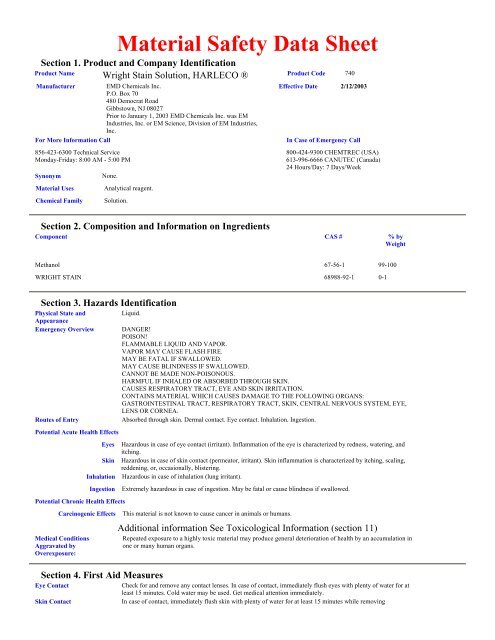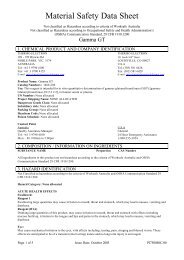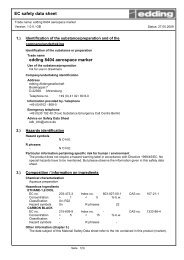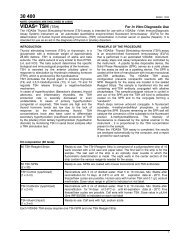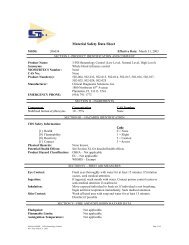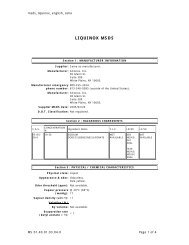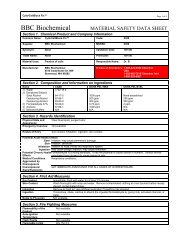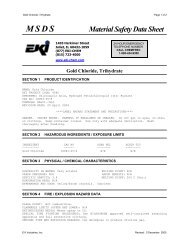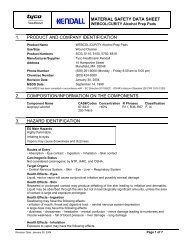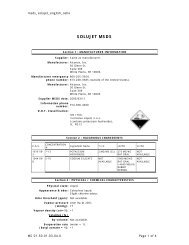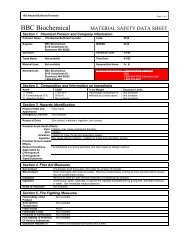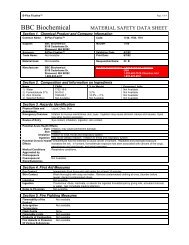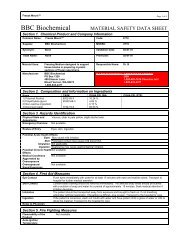Wright Stain Solution - Mercedes Medical
Wright Stain Solution - Mercedes Medical
Wright Stain Solution - Mercedes Medical
You also want an ePaper? Increase the reach of your titles
YUMPU automatically turns print PDFs into web optimized ePapers that Google loves.
Material Safety Data SheetSection 1. Product and Company IdentificationProduct Name<strong>Wright</strong> <strong>Stain</strong> <strong>Solution</strong>, HARLECO ®Product Code 740Manufacturer EMD Chemicals Inc.P.O. Box 70480 Democrat RoadGibbstown, NJ 08027Prior to January 1, 2003 EMD Chemicals Inc. was EMIndustries, Inc. or EM Science, Division of EM Industries,Inc.For More Information Call856-423-6300 Technical ServiceMonday-Friday: 8:00 AM - 5:00 PMSynonymMaterial UsesChemical FamilyNone.Analytical reagent.<strong>Solution</strong>.Effective Date 2/12/2003In Case of Emergency Call800-424-9300 CHEMTREC (USA)613-996-6666 CANUTEC (Canada)24 Hours/Day: 7 Days/WeekSection 2. Composition and Information on IngredientsComponent CAS # % byWeightMethanol 67-56-1 99-100WRIGHT STAIN 68988-92-1 0-1Section 3. Hazards IdentificationPhysical State andAppearanceEmergency OverviewRoutes of EntryPotential Acute Health EffectsPotential Chronic Health EffectsLiquid.DANGER!POISON!FLAMMABLE LIQUID AND VAPOR.VAPOR MAY CAUSE FLASH FIRE.MAY BE FATAL IF SWALLOWED.MAY CAUSE BLINDNESS IF SWALLOWED.CANNOT BE MADE NON-POISONOUS.HARMFUL IF INHALED OR ABSORBED THROUGH SKIN.CAUSES RESPIRATORY TRACT, EYE AND SKIN IRRITATION.CONTAINS MATERIAL WHICH CAUSES DAMAGE TO THE FOLLOWING ORGANS:GASTROINTESTINAL TRACT, RESPIRATORY TRACT, SKIN, CENTRAL NERVOUS SYSTEM, EYE,LENS OR CORNEA.Absorbed through skin. Dermal contact. Eye contact. Inhalation. Ingestion.Eyes Hazardous in case of eye contact (irritant). Inflammation of the eye is characterized by redness, watering, anditching.Skin Hazardous in case of skin contact (permeator, irritant). Skin inflammation is characterized by itching, scaling,reddening, or, occasionally, blistering.Inhalation Hazardous in case of inhalation (lung irritant).Ingestion Extremely hazardous in case of ingestion. May be fatal or cause blindness if swallowed.Carcinogenic Effects This material is not known to cause cancer in animals or humans.<strong>Medical</strong> ConditionsAggravated byOverexposure:Section 4. First Aid MeasuresEye ContactSkin ContactAdditional information See Toxicological Information (section 11)Repeated exposure to a highly toxic material may produce general deterioration of health by an accumulation inone or many human organs.Check for and remove any contact lenses. In case of contact, immediately flush eyes with plenty of water for atleast 15 minutes. Cold water may be used. Get medical attention immediately.In case of contact, immediately flush skin with plenty of water for at least 15 minutes while removing
InhalationIngestioncontaminated clothing and shoes. Cover the irritated skin with an emollient. Cold water may be used. Washclothing before reuse. Thoroughly clean shoes before reuse. Get medical attention immediately.If inhaled, remove to fresh air. If not breathing, give artificial respiration. If breathing is difficult, give oxygen.Get medical attention immediately.If swallowed, do not induce vomiting unless directed to do so by medical personnel. Never give anything bymouth to an unconscious person. Loosen tight clothing such as a collar, tie, belt or waistband. Get medicalattention immediately.Section 5. Fire Fighting MeasuresFlammability of the Product Product will burn.Auto-ignition TemperatureFlash PointsFlammable LimitsProducts of CombustionFire Hazards in Presence ofVarious SubstancesExplosion Hazards inPresence of VariousSubstancesThe lowest known value is 464.05°C (867.3°F) (METHANOL).The lowest known value is Open cup: 15.9°C (60.6°F). (METHANOL)The greatest known range is LOWER: 6% UPPER: 36.5% (METHANOL)These products are carbon oxides (CO, CO2).Highly flammable in presence of open flames, sparks and static discharge, of heat, of oxidizing materials.Risks of explosion of the product in presence of static discharge:Highly flammable in presence of open flames, sparks and static discharge.Highly explosive in presence of open flames, sparks and static discharge.Fire Fighting Mediaand InstructionsProtective Clothing (Fire)Special Remarks on FireHazardsSpecial Remarks onExplosion HazardsRisks of explosion of the product in presence of mechanical impact: No.SMALL FIRE: Use DRY chemical powder.LARGE FIRE: Use alcohol foam, water spray or fog. Cool containing vessels with water jet in order to preventpressure build-up, autoignition or explosion.Be sure to use an approved/certified respirator or equivalent.Dangerous fire and explosion risk. Container explosion may occur under fire conditions or when heated. Vapormay travel considerable distance to source of ignition and flash back. (METHANOL)Not available.Section 6. Accidental Release MeasuresSmall Spill and LeakLarge Spill and LeakSpill Kit InformationSection 7. Handling and StorageHandlingStorageDilute with water and mop up, or absorb with an inert dry material and place in an appropriate waste disposalcontainer.Keep away from heat. Keep away from sources of ignition. Stop leak if without risk. Absorb with DRY earth,sand or other non-combustible material. Do not get water inside container. Do not touch spilled material. Usewater spray to reduce vapors. Prevent entry into sewers, basements or confined areas; dike if needed. Call forassistance on disposal. Be careful that the product is not present at a concentration level above TLV. Check TLVon the MSDS and with local authorities.The following EMD Chemicals Inc. SpillSolv ® absorbent is recommended for this product: SX1330 SolventTreatment KitKeep away from heat, sparks and flame. Keep container closed. Avoid breathing vapors or spray mists. Do notget in eyes, on skin, or on clothing. Do not ingest.Keep container in a cool, well-ventilated area.Section 8. Exposure Controls/Personal ProtectionEngineering ControlsPersonal ProtectionProtective Clothing(Pictograms)Personal Protection in Caseof a Large SpillProvide exhaust ventilation or other engineering controls to keep the airborne concentrations of vapors belowtheir respective occupational exposure limits. Ensure that eyewash stations and safety showers are proximal tothe work-station location.Eyes Splash goggles.Body Lab coat.Respiratory Vapor respirator. Be sure to use an approved/certified respirator or equivalent. Wear appropriate respirator whenventilation is inadequate.Hands Gloves.Feet Not applicable.Splash goggles. Full suit. Vapor respirator. Boots. Gloves. A self-contained breathing apparatus should be usedto avoid inhalation of the product. Suggested protective clothing might not be sufficient; consult a specialistBEFORE handling this product.
Product NameExposure LimitsMethanolWRIGHT STAINACGIH (United States, 1994). SkinTWA: 262 mg/m3STEL: 328 mg/m3OSHA (United States, 1989). SkinTWA: 260 mg/m3STEL: 325 mg/m3ACGIH (United States, 1994). SkinSTEL: 328 mg/m3 15 minute(s).STEL: 250 ppm 15 minute(s).TWA: 262 mg/m3 8 hour(s).TWA: 200 ppm 8 hour(s).NIOSH REL (United States, 1994). SkinSTEL: 325 mg/m3 15 minute(s).STEL: 250 ppm 15 minute(s).TWA: 260 mg/m3 10 hour(s).TWA: 200 ppm 10 hour(s).OSHA Final Rule (United States, 1989). SkinSTEL: 325 mg/m3 15 minute(s).STEL: 250 ppm 15 minute(s).TWA: 260 mg/m3 8 hour(s).TWA: 200 ppm 8 hour(s).Not available.Section 9. Physical and Chemical PropertiesOdorCharacteristic. Alcohol like.ColorPhysical State andAppearanceMolecular WeightMolecular FormulapHBoiling/Condensation PointMelting/Freezing PointSpecific GravityVapor PressureVapor DensityVolatilityOdor ThresholdEvaporation RatePurple.Liquid.Not applicable.Not applicable.Not available.VOC 100 (%)LogKowSolubilityThe lowest known value is 64.55°C (148.2°F) (METHANOL).May start to solidify at -97.72°C (-143.9°F) based on data for: METHANOL.The only known value is 0.792 (Water = 1) (METHANOL).The highest known value is 12.9 kPa (97 mmHg) (@ 20°C) (METHANOL).The highest known value is 1.11 (Air = 1) (METHANOL).99.9% (v/v). (METHANOL.)The lowest known value is 100 ppm (METHANOL)5.91 (METHANOL) compared to (n-BUTYL ACETATE=1)Not available.Soluble in water.Section 10. Stability and ReactivityStability and Reactivity The product is stable.Conditions of InstabilityIncompatibility with VariousSubstancesRem/IncompatibilityHazardous DecompositionProductsHazardous PolymerizationNot available.Highly reactive with oxidizing agents.Reactive with metals, acids.Not available.Not available.Will not occur.Section 11. Toxicological InformationRTECS Number:
Methanol PC1400000ToxicityChronic Effects on HumansAcute Effects on HumansSynergetic Products(Toxicologically)IrritancySensitizationCarcinogenic EffectsToxicity to ReproductiveSystemTeratogenic EffectsMutagenic Effects<strong>Wright</strong> <strong>Stain</strong>Not available.Acute oral toxicity (LD50): 5628 mg/kg [Rat]. (METHANOL).Acute dermal toxicity (LD50): 15800 mg/kg [Rabbit]. (METHANOL).Acute toxicity of the vapor (LC50): 64000 ppm 4 hour(s) [Rat]. (METHANOL).Not available.Hazardous in case of eye contact (irritant). Inflammation of the eye is characterized by redness, watering, anditching. Hazardous in case of skin contact (permeator, irritant). Skin inflammation is characterized by itching,scaling, reddening, or, occasionally, blistering. Hazardous in case of inhalation (lung irritant). Extremelyhazardous in case of ingestion. May be fatal if swallowed.Not available.Draize Test: Not available.Not available.This material is not known to cause cancer in animals or humans.Not available.Not available.Not available.Section 12. Ecological InformationEcotoxicityNot available.BOD5 and CODToxicity of the Products ofBiodegradationNot available.Section 13. Disposal ConsiderationsEPA Waste Number U154 D001TreatmentSection 14. Transport InformationDOT ClassificationTDG ClassificationIMO/IMDG ClassificationICAO/IATA ClassificationThe products of degradation are less toxic than the product itself.Incineration, fuels blending or recycle. Contact your local permitted waste disposal site (TSD) for permissibletreatment sites. Always contact a permitted waste disposal (TSD) to assure compliance with all current local,state, and Federal Regulations..Proper Shipping Name: METHANOL SOLUTIONHazard Class: 3UN number: UN1230Packing Group: IIRQ: Not applicable.Not available.Not available.Not available.Section 15. Regulatory InformationU.S. Federal Regulations TSCA 8(b) inventory: METHANOL; WRIGHT STAINWHMIS (Canada)SARA 302/304/311/312 extremely hazardous substances: No products were found.SARA 302/304 emergency planning and notification: No products were found.SARA 302/304/311/312 hazardous chemicals: METHANOLSARA 311/312 MSDS distribution - chemical inventory - hazard identification: METHANOL: Fire Hazard,Immediate (Acute) Health Hazard, Delayed (Chronic) Health HazardSARA 313 toxic chemical notification and release reporting: METHANOL 99.5%Clean Water Act (CWA) 307: No products were found.Clean Water Act (CWA) 311: No products were found.Clean air act (CAA) 112 accidental release prevention: No products were found.Clean air act (CAA) 112 regulated flammable substances: No products were found.Clean air act (CAA) 112 regulated toxic substances: No products were found.Class D-1A: Material causing immediate and serious toxic effects (VERY TOXIC).Class D-2B: Material causing other toxic effects (TOXIC).
International RegulationsCEPA DSL: METHANOL; WRIGHT STAINThis product has been classifed in accordance with the hazard criteria of the Controlled Product Regulations andthe MSDS contains all required information.EINECS METHANOL 200-659-6WRIGHT STAIN 273-541-5DSCL (EEC) R11- Highly flammable.R37/38- Irritating to respiratory system and skin.R41- Risk of serious damage to eyes.International Lists Australia (NICNAS): METHANOL; WRIGHT STAINJapan (MITI): METHANOLKorea (TCCL): METHANOLPhilippines (RA6969): METHANOL; WRIGHT STAINChina: No products were found.State RegulationsPennsylvania RTK: METHANOL: (environmental hazard, generic environmental hazard)Massachusetts RTK: METHANOLNew Jersey: METHANOLCalifornia prop. 65: No products were found.Section 16. Other InformationChanged Since LastRevisionNotice to Reader+National FireProtectionAssociation(U.S.A.)3Health 1 0Fire HazardReactivitySpecific HazardThe statements contained herein are based upon technical data that EMD Chemicals Inc. believes to be reliable, are offered forinformation purposes only and as a guide to the appropriate precautionary and emergency handling of the material by a properlytrained person having the necessary technical skills. Users should consider these data only as a supplement to other information gatheredby them and must make independent determinations of suitability and completeness of information from all sources to assure proper use,storage and disposal of these materials and the safety and health of employees and customers and the protection of the environment.EMD CHEMICALS INC. MAKES NO REPRESENTATION OR WARRANTY OF ANY KIND, EXPRESS OR IMPLIED,INCLUDING MERCHANTABILITY OR FITNESS FOR A PARTICULAR USE, WITH RESPECT TO THE INFORMATIONHEREIN OR THE PRODUCT TO WHICH THE INFORMATION REFERS.


